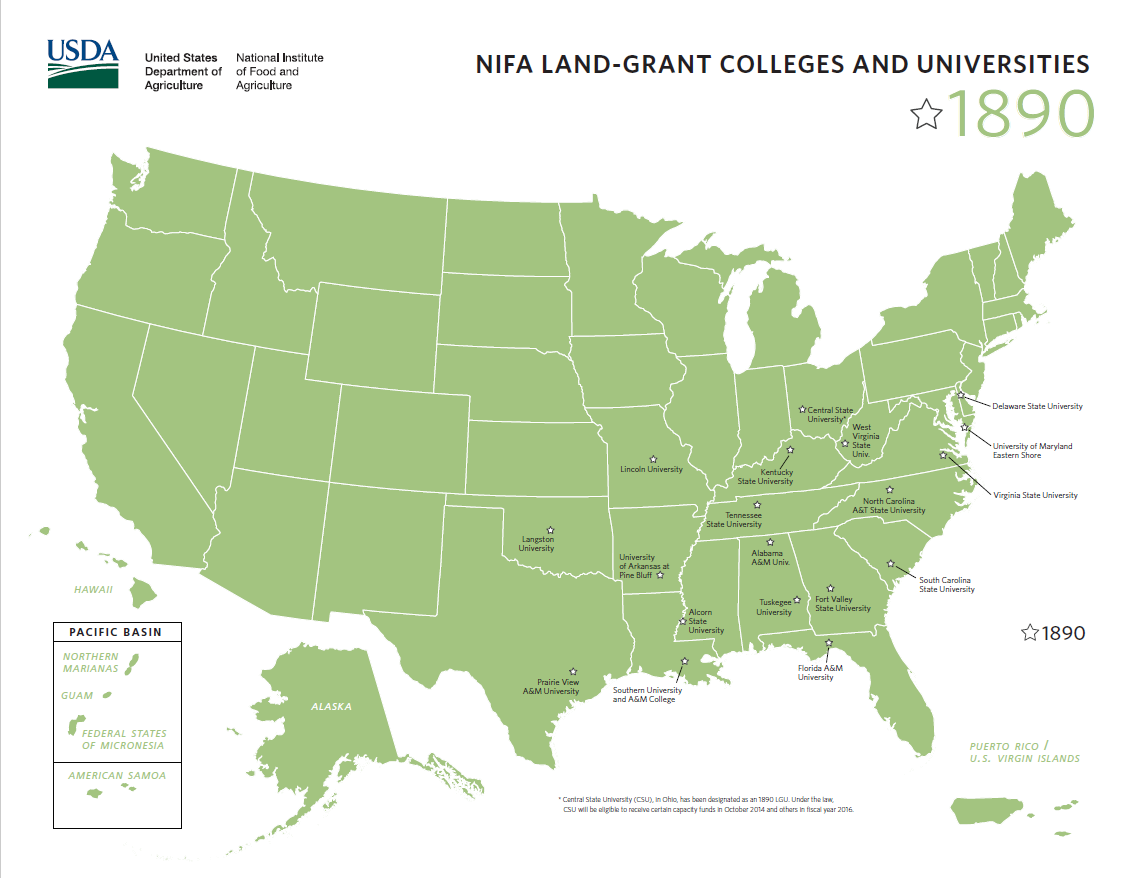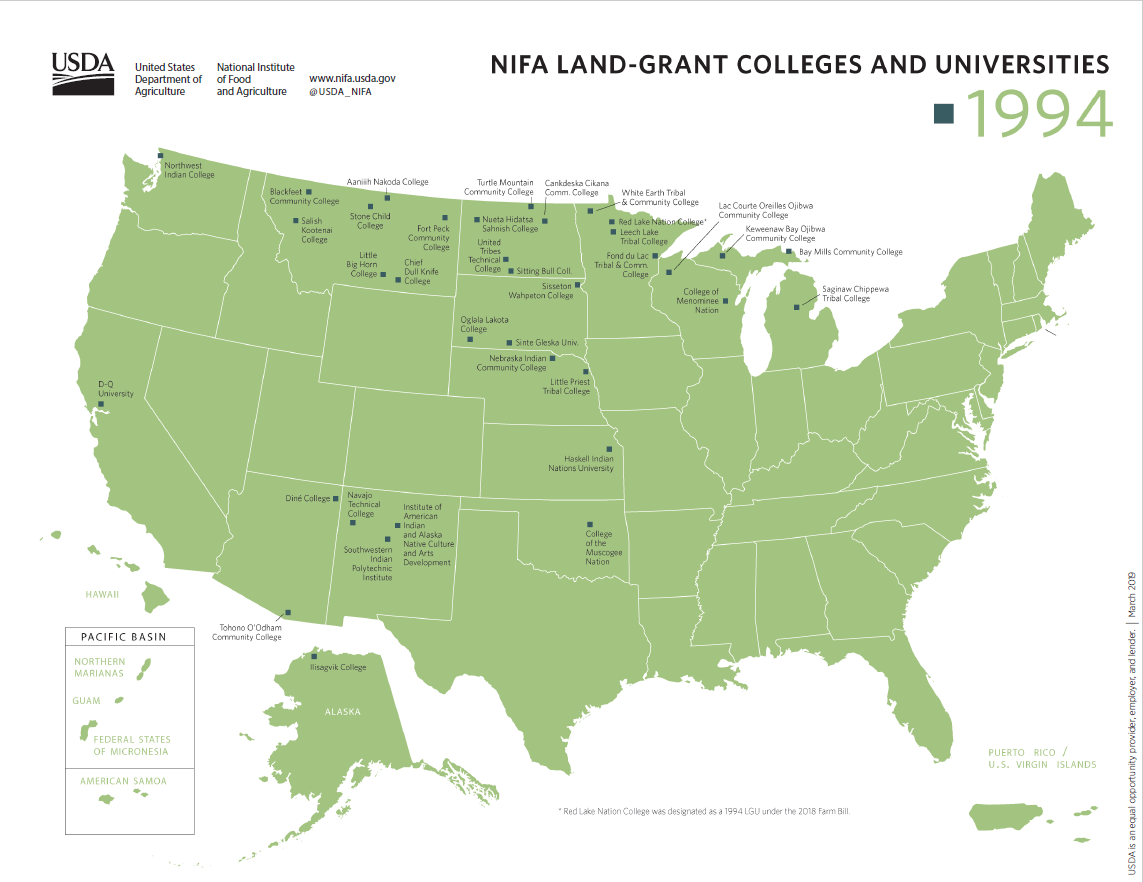Last week we learned about the Morrill Act of 1862 and the resulting land-grant colleges. This Friday Footnote will focus on the Second Morrill Act of 1890. What did the 1890 Morrill Act accomplish and why was it needed? We will also look at 1994 land-grant colleges.
After the initial wave of 1862 land-grant colleges were established, several problems surfaced. The first problem was financial. The land-grant colleges needed more funding to support their efforts. Because of depressed land prices after the Civil War, the sale of public lands did not generate enough money to adequately endow these colleges.
A second concern was accountability. The accountability measures in the 1862 Act were minimal and needed to be more robust.
A third problem had to do with the interpretation of the language of the original Morrill Act. Exactly what did “…to teach such branches of learning as are related to agriculture and the mechanic arts” really mean? At least one land-grant college claimed they did not have to teach classes in agriculture and mechanical arts because they were teaching biology, geology, and chemistry which was definitely “related to agricultural and mechanical arts.” Clarification about specifically what was to be taught was needed.
Senator Justin Morrill introduced legislation in 1872, 1873 and in six other years prior to 1890 to address these issues but the legislation failed each time. One of the reasons for the failure was the reputation of the fledgling land-grant colleges. An article titled “The Ivory Silo: Farmer-Agricultural College Tensions in the 1870s and 1880s” in the journal Agricultural History documents the problems. The first sentence in the Marcus article (1986, p. 22) reads “Farmers persistently voiced dissatisfaction, even disgust, with the condition of American agricultural colleges in the 1870s and 1880s.” To put it bluntly, farmers were not pleased with these new colleges.
But the major reason Morrill’s proposed legislation failed had to do with racial discrimination in regard to admission into the land-grant colleges in the south. Congress was not willing to increase funding for land-grant colleges because the land-grant institutions in the south would not admit students of color. Congress did not want to reward this discriminatory practice by increasing the funding that would benefit institutions that practiced racial discrimination.
Eventually, a compromise was reached. The final wording of the compromise in the 1890 Morrill Act was as follows:
“no money shall be paid out under this act to any State or Territory for the support and maintenance of a college where a distinction of race or color is made in the admission of students, but the establishment and maintenance of such colleges separately for white and colored students shall be held to be a compliance with the provisions of this act if the funds received in such State or Territory be equitably divided as hereinafter set forth”
In simple English, this provision called for the establishment of land-grant colleges for “colored students” in the states where they could not attend the 1862 land-grant colleges because of their discriminatory admission requirements.
As a result of this provision in the 2nd Morrill Act the following institutions were created or have been recognized since as “1890 land-grant colleges.”
Table 1 1890 Land-Grant Institutions
Institution……………………………. Year Founded…… Location
Alabama A&M University……………….. 1873…………. Normal, Alabama
Alcorn State University………………..… 1871…………. Lorman, Mississippi
Central State University……………….... 1887…………. Wilberforce, Ohio
Delaware State University………………. 1891…………. Dover, Delaware
Florida A&M University………………..… 1887…………. Tallahassee, Florida
Fort Valley State University…………….. 1895…………. Fort Valley, Georgia
Kentucky State University………………. 1886…………. Frankfort, Kentucky
Langston University………………..…….. 1897…………. Langston, Oklahoma
Lincoln University………………..……….. 1866…………. Jefferson City, Missouri
North Carolina A&T State University…. 1891…………. Greensboro, North Carolina
Prairie View A&M University…………… 1876…………. Prairie View, Texas
South Carolina State University……….. 1896…………. Orangeburg, South Carolina
Southern University………………..…….. 1880…………. Baton Rouge, Louisiana
Tennessee State University…………….. 1912…………. Nashville, Tennessee
Tuskegee University………………..……. 1881…………. Tuskegee, Alabama
University of Arkansas Pine Bluff……… 1873…………. Pine Bluff, Arkansas
University of Maryland Eastern Shore.. 1886…………. Princess Anne, Maryland
Virginia State University……………….... 1882…………. Petersburg, Virginia
West Virginia State University…………. 1891…………. Institute, West Virginia
The following map shows the location of the 1890 institutions (link to a larger map). (A map showing the 1862 land-grants can be found at this USDA site).

The 1890 Morrill Act did provide additional funding to the land-grant colleges but if you carefully read the 2nd Morrill Act you will find the words “the funds received in such State or Territory [are to] be equitably divided”. Note the phrases IS NOT “equally divided.” So, what did “equitable” mean in the southern states and who made that determination? Basically, the state legislatures in the southern states decided how much money would go to the 1862 land-grant institution and the 1890 land-grant institution. In practice, most of the funding went to the 1862 institutions with a much smaller amount going to the 1890s. The rationale went something like this – the two colleges have an enrollment of 1000. There are 900 students at the 1862 institution since the are established but only 100 students at the 1890 institution, so the 1862 land-grant college will get 90% of the funds. The newly created 1890 institutions were financially handicapped from the start.
When asked, most people would state the 1890 Morrill Act as established the black land-grant colleges. It is true this happened but that was not the primary intent of the act. If you read the first paragraph of the Second Morrill Act it states:
Chap. 841.–AN ACT To apply a portion of the proceeds of the public lands to the more complete endowment and support of the colleges for the benefit of agriculture and the mechanic arts established under the provisions of an act of Congress approved July second, eighteen hundred and sixty-two.
According to the above paragraph, the purpose of the Act was to provide more funding to the 1862 land-grant colleges. The original intent was not the creation of black land-grant colleges but that was the compromise in order to ensure passage of the legislation.
Another provision of the 1890 Act made it crystal-clear what the land grant colleges were to teach. The first section of the Act indicates the funds provided by the act are “…to be applied only to instruction in agriculture and mechanic arts, the English language and the various branches of mathematical, physical, natural and economic science, with special reference to their applications in the industries of life, and to the facilities for such instruction.” So, the land-grant colleges were mandated to provide instruction in “agriculture and mechanical arts” and were to teach English. Therefore, don’t claim that funds are to be used to teach Latin and Greek and “subjects related” to agriculture and mechanical arts as some of the early leaders of the land-grant colleges did.
There was also a provision requiring an annual detailed report to the “Secretary of Agriculture, as well as to the Secretary of Education.” The legislation specified exactly what was to be reported. This was to ensure greater accountability.
The 1890 land-grant colleges have played an important role in the development of agriculture and agricultural education. Thousands of students were able to pursue degrees in agriculture in states where they were denied admission to the 1862 land-grant colleges. Many of these students have gone on to become agriculture teachers and extension agents and to assume major leadership and scientific positions, including being professors and scholars in agricultural and extension education. We also don’t want to forget that faculty at the 1890 institutions provided the leadership for the New Farmers of America. The agricultural and extension education profession, including our youth organizations, is much stronger today because of the 1890 land-grant colleges.
The 1994 Land-Grant Colleges
Have you heard about the 1994 land-grant colleges? They are the newest members of the land-grant family. On October 20, 1994, President Bill Clinton signed into law the Equity in Educational Land-Grant Status Act, which designated tribal colleges and universities (TCUs) as land grant institutions. The new act allocated a one-time endowment of $23 million to be divided among 29 tribal colleges. Thereafter, funds would be allocated based on student enrollment.
By receiving land-grant university status, these colleges had access to federal government resources that would improve the lives of Native students (there are now 34 recognized tribal colleges). These government resources support research, education, and extension programs that positively impact agriculture and food production for Native Americans. Detailed information about the 1994 land-grant institutions is contained in this USDA brochure. The map below shows the location of the 1994 land-grant institutions (link to a larger map).

Teaching Ideas
- Have your students select one 1862, 1890 or 1994 land-grant college and prepare a report about the institution. Where is it located and what are some of the notable facts or programs offered at the institution.
- The 1890 institutions celebrated their 125thanniversary in 2015. Several videos were produced about the Second Morrill Act. One of the best is this 8 minute video from the University of Maryland – Eastern Shore. It is definitely worth showing to your students.
- A quick search of YouTube reveals a multitude of videos about the 1862 land-grant institutions that were produced in 2012, the 150th anniversary of the original Morrill Act. You can probably find one about your state if you want to show a video about the 1862 land-grants.
References
Marcus, A. (1986). The Ivory Silo: Farmer-Agricultural College Tensions in the 1870s and 1880s. Agricultural History, Vol. 60, No. 2.
